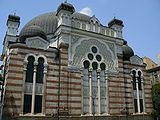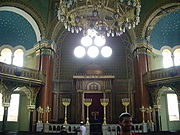
Sofia Synagogue
Encyclopedia
The Sofia Synagogue is the largest synagogue
in Southeastern Europe, one of two functioning in Bulgaria
and the third-largest in Europe
.
Constructed for the needs of the Bulgarian capital Sofia
's mainly Sephardic Jewish community after a project by the Austria
n architect Friedrich Grünanger
, it resembles the old Moorish Leopoldstädter Tempel
in Vienna
and was officially opened on 9 September 1909 in the presence of Tsar
Ferdinand I of Bulgaria
. The first preparations for the synagogue's construction date to 1903, while the construction itself had begun on 13 November 1905. The construction of a grand new synagogue was part of the reorganization efforts of the Bulgarian Jewish community under Lemberg
-born Chief Rabbi
Marcus Ehrenpreis and local leaders Ezra Tadjer and Avram Davidjon Levy. Prior to the construction of the new synagogue, the lot in central Sofia had been occupied by an older synagogue.
 One of the architectural monuments of Sofia, the synagogue, located in the very centre of the city near the Central Market Hall
One of the architectural monuments of Sofia, the synagogue, located in the very centre of the city near the Central Market Hall
, can accommodate 1,300 worshippers. The Sofia Synagogue's main chandelier
weighs 1.7 ton
s and is the largest in the country.
Despite the building's size, the services
are normally only attended by some 50 to 60 worshippers due to the aliyah
of most of Bulgaria's Jews to Israel
and the secularity
of the local Jewish population.
The architectural style is essentially Moorish Revival
, with elements of the Vienna Secession
and, in the facade, Venetian
architecture. The main premise has a diameter of 20 m and is 31 m high. It is topped by an octagonal dome. The interior is richly decorated, featuring columns of Carrara
marble and multicoloured Venetian mosaics, as well as decorative woodcarving. The entire building takes up 659 m².
Since 8 May 1992 the Sofia Synagogue also houses the Jewish Museum of History, which includes the Jewish Communities in Bulgaria and the Holocaust and the Salvation of the Jews in Bulgaria expositions. A souvenir shop is also in operation.
Synagogue
A synagogue is a Jewish house of prayer. This use of the Greek term synagogue originates in the Septuagint where it sometimes translates the Hebrew word for assembly, kahal...
in Southeastern Europe, one of two functioning in Bulgaria
Bulgaria
Bulgaria , officially the Republic of Bulgaria , is a parliamentary democracy within a unitary constitutional republic in Southeast Europe. The country borders Romania to the north, Serbia and Macedonia to the west, Greece and Turkey to the south, as well as the Black Sea to the east...
and the third-largest in Europe
Europe
Europe is, by convention, one of the world's seven continents. Comprising the westernmost peninsula of Eurasia, Europe is generally 'divided' from Asia to its east by the watershed divides of the Ural and Caucasus Mountains, the Ural River, the Caspian and Black Seas, and the waterways connecting...
.
Constructed for the needs of the Bulgarian capital Sofia
Sofia
Sofia is the capital and largest city of Bulgaria and the 12th largest city in the European Union with a population of 1.27 million people. It is located in western Bulgaria, at the foot of Mount Vitosha and approximately at the centre of the Balkan Peninsula.Prehistoric settlements were excavated...
's mainly Sephardic Jewish community after a project by the Austria
Austria
Austria , officially the Republic of Austria , is a landlocked country of roughly 8.4 million people in Central Europe. It is bordered by the Czech Republic and Germany to the north, Slovakia and Hungary to the east, Slovenia and Italy to the south, and Switzerland and Liechtenstein to the...
n architect Friedrich Grünanger
Friedrich Grünanger
Friedrich Grünanger was an Austro-Hungarian architect who worked primarily in Bulgaria.Born in Schäßburg in Austria-Hungary , Grünanger studied at the Academy of Fine Arts Vienna architecture school between 1877 and 1879, under Friedrich von Schmidt...
, it resembles the old Moorish Leopoldstädter Tempel
Leopoldstädter Tempel
The Leopoldstädter Tempel was the largest synagogue of Vienna, in the district of Leopoldstadt. It was also known as the Israelitische Bethaus in der Wiener Vorstadt Leopoldstadt. It was built in 1858 in a Moorish Revival style by the architect Ludwig Förster...
in Vienna
Vienna
Vienna is the capital and largest city of the Republic of Austria and one of the nine states of Austria. Vienna is Austria's primary city, with a population of about 1.723 million , and is by far the largest city in Austria, as well as its cultural, economic, and political centre...
and was officially opened on 9 September 1909 in the presence of Tsar
Tsar
Tsar is a title used to designate certain European Slavic monarchs or supreme rulers. As a system of government in the Tsardom of Russia and Russian Empire, it is known as Tsarist autocracy, or Tsarism...
Ferdinand I of Bulgaria
Ferdinand I of Bulgaria
Ferdinand , born Ferdinand Maximilian Karl Leopold Maria of Saxe-Coburg and Gotha-Koháry, was the ruler of Bulgaria from 1887 to 1918, first as knyaz and later as tsar...
. The first preparations for the synagogue's construction date to 1903, while the construction itself had begun on 13 November 1905. The construction of a grand new synagogue was part of the reorganization efforts of the Bulgarian Jewish community under Lemberg
Lviv
Lviv is a city in western Ukraine. The city is regarded as one of the main cultural centres of today's Ukraine and historically has also been a major Polish and Jewish cultural center, as Poles and Jews were the two main ethnicities of the city until the outbreak of World War II and the following...
-born Chief Rabbi
Chief Rabbi
Chief Rabbi is a title given in several countries to the recognized religious leader of that country's Jewish community, or to a rabbinic leader appointed by the local secular authorities...
Marcus Ehrenpreis and local leaders Ezra Tadjer and Avram Davidjon Levy. Prior to the construction of the new synagogue, the lot in central Sofia had been occupied by an older synagogue.

Central Sofia Market Hall
The Central Sofia Market Hall , known popularly simply as The Market Hall is a covered market in the centre of Sofia, the capital of Bulgaria, located on Marie Louise Boulevard...
, can accommodate 1,300 worshippers. The Sofia Synagogue's main chandelier
Chandelier
A chandelier is a branched decorative ceiling-mounted light fixture with two or more arms bearing lights. Chandeliers are often ornate, containing dozens of lamps and complex arrays of glass or crystal prisms to illuminate a room with refracted light...
weighs 1.7 ton
Ton
The ton is a unit of measure. It has a long history and has acquired a number of meanings and uses over the years. It is used principally as a unit of weight, and as a unit of volume. It can also be used as a measure of energy, for truck classification, or as a colloquial term.It is derived from...
s and is the largest in the country.
Despite the building's size, the services
Jewish services
Jewish prayer are the prayer recitations that form part of the observance of Judaism. These prayers, often with instructions and commentary, are found in the siddur, the traditional Jewish prayer book....
are normally only attended by some 50 to 60 worshippers due to the aliyah
Aliyah
Aliyah is the immigration of Jews to the Land of Israel . It is a basic tenet of Zionist ideology. The opposite action, emigration from Israel, is referred to as yerida . The return to the Holy Land has been a Jewish aspiration since the Babylonian exile...
of most of Bulgaria's Jews to Israel
Israel
The State of Israel is a parliamentary republic located in the Middle East, along the eastern shore of the Mediterranean Sea...
and the secularity
Secularity
Secularity is the state of being separate from religion.For instance, eating and bathing may be regarded as examples of secular activities, because there may not be anything inherently religious about them...
of the local Jewish population.
The architectural style is essentially Moorish Revival
Moorish Revival
Moorish Revival or Neo-Moorish is one of the exotic revival architectural styles that were adopted by architects of Europe and the Americas in the wake of the Romanticist fascination with all things oriental...
, with elements of the Vienna Secession
Vienna Secession
The Vienna Secession was formed in 1897 by a group of Austrian artists who had resigned from the Association of Austrian Artists, housed in the Vienna Künstlerhaus. This movement included painters, sculptors, and architects...
and, in the facade, Venetian
Venice
Venice is a city in northern Italy which is renowned for the beauty of its setting, its architecture and its artworks. It is the capital of the Veneto region...
architecture. The main premise has a diameter of 20 m and is 31 m high. It is topped by an octagonal dome. The interior is richly decorated, featuring columns of Carrara
Carrara
Carrara is a city and comune in the province of Massa-Carrara , notable for the white or blue-grey marble quarried there. It is on the Carrione River, some west-northwest of Florence....
marble and multicoloured Venetian mosaics, as well as decorative woodcarving. The entire building takes up 659 m².
Since 8 May 1992 the Sofia Synagogue also houses the Jewish Museum of History, which includes the Jewish Communities in Bulgaria and the Holocaust and the Salvation of the Jews in Bulgaria expositions. A souvenir shop is also in operation.

